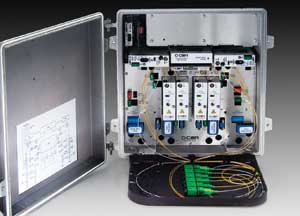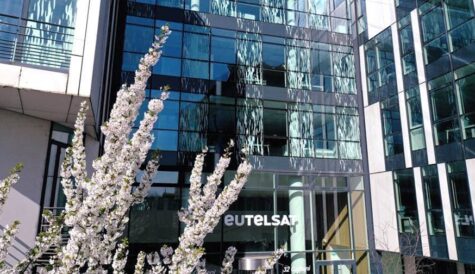
After more than 40 years of operation, DTVE is closing its doors and our website will no longer be updated daily. Thank you for all of your support.
Access all areas
As the battle for broadband subscribers heats up, investment by telecom and cable operators in next-generation infrastructure is accelerating. But how do the technology choices compare? Stuart Thomson investigates.
As telecom and cable operators battle it out to win broadband subscribers, their ability to offer faster downstream speeds than the competition has become a key marketing tool. Until recently, however, few consumers have actually used very high-speed networks to their full potential.
That could be changing. Demand for higher and higher download speeds is being driven above all by video. More people are going online to watch streaming video services such as BBC iPlayer, and they are staying online longer. “Bandwidth means video,” says John Cunliffe, chief technology officer at Ericsson UK. “The next demand will be unicast as opposed to broadcast.”
This means demand for bandwidth previously only sought by companies and other organisations is being driven above all by consumers. “In 2008, private residential internet usage exceeded business usage. This means that Joe Public is now using more bandwidth than the average corporate business when it comes to both downloading videos, music and so on and uploading pictures, home made videos etc.,” says Edgar Aker, director, marketing and products at fibre-to-the-home specialist Draka Telecom Solutions. “The gap between private and business internet usage will continue to grow in the coming years – business usage will have a gradual growth whereas the personal use of bandwidth will explode.”
 Bill Dawson, vice-president of business development and product strategy at broadband cable technology provider Arris, agrees. “What’s happened in North America is that downstream data has historically been increasing more or less in accordance with Moore’s law,” says Dawson. “But that’s just on the data side. Voice will not add a lot of capacity demand but video will, particularly as HD becomes more widespread.”
Bill Dawson, vice-president of business development and product strategy at broadband cable technology provider Arris, agrees. “What’s happened in North America is that downstream data has historically been increasing more or less in accordance with Moore’s law,” says Dawson. “But that’s just on the data side. Voice will not add a lot of capacity demand but video will, particularly as HD becomes more widespread.”
For telcos, the decision to deploy IPTV clearly has kick-started next-generation network upgrades in a number of cases. HD requires about 8-9Mbps even with advanced compression, which means that providing multiple HD streams – an essential feature for DVR subscribers – will very quickly eat up bandwidth. The launch of 3DTV services in the near future by operators such as BSkyB will put pressure on fixed-line operators to follow suit.
Options for telcos
Telecom operators face a much more urgent bandwidth challenge than cable providers with up-to-date HFC networks. Faced with a choice between implementing the expensive civil engineering works that would be necessary to deliver fibre to every subscriber, many are opting for VDSL2, which requires fibre to be laid to street cabinets or buildings but still makes use of existing copper pairs beyond that point. Amongst the FTTH technologies, the most capex-efficient, Gigabit Passive Optical Networks (GPON), which use a shared fibre to deliver bandwidth to close to individual premises, can cost about five times as much, according to Gavin Young, chair of the technical committee of the Broadband Access Forum (while point-to-point fibre, which delivers individual fibres to each premises, can cost up to 30% more again, he says).
Marcus Weldon, chief technology officer at Alcatel Lucent, says that demand for both VDSL2 and GPON equipment from telcos is growing. While the latter is growing faster in relative terms, this is from a much smaller base. The alternative technology of EPON is also growing but remains largely restricted to Asia, while Active Ethernet and point-to-point technologies are also favoured by small network providers such as municipalities. According to Weldon, FTTH deployments, at least in western markets, have coalesced around GPON, which can be deployed with 10-15% less operating and capital expenditure than alternative technologies.
Further down the line, Weldon believes there will also be demand for 10Gbps PON services, in part to cater for enterprise applications but also to add more residential subscribers to an individual PON than is possible with 2.5Gbps networks (providing further efficiencies) or to serve apartment buildings.
Not everyone agrees with this assessment. Draka’s Aker says that the FTTH Council, of which Draka is a member, expects about 21 million European homes to be connected to FTTH networks by 2013, of which a full 75% will be provided by non-traditional suppliers. “The FTTH Council expects this network to be predominantly point-to-point, not PON because telcos will not drive it,” says Aker, who expects the Russian market to account for a large number of FTTH homes overall, while Sweden and Slovenia are the current frontrunners in terms of penetration. “Telcos have a tendency to choose xPON networks, because they don’t support a multi-operator approach,” says Akers. “Their first priority is to utilise their existing networks as long as they can. However, they are pushed by competition, primarily from the cable TV operators – as their coax networks are more flexible – and then by new entrants that are deploying a ‘real’ FTTH network.”
According to Aker, GPON and Ethernet PON are popular with established operators because they permit a phased approach, reducing capex but increasing opex because there is still a need for active equipment in the network, while point-to-point solutions are favoured by new entrants because they tie in with a multi-operator approach and lead to reduced opex in the long run.
Time to market
 The choice telcos make between FTTH and VDSL2 will depend on a number of factors. Alcatel Lucent’s Weldon says that in areas where cable is aggressively marketing high-bandwidth services, telcos are more likely to opt for the quicker fix of fibre-to-the-node technologies than to push fibre to the end users, because it offers a faster time to market for less capex. (There are some exceptions, such as US operator Verizon, which has pushed fibre to the premises in a hybrid configuration using DOCSIS technology in the home, but Weldon points out that most of Verizon’s last-mile plant is aerial, making the upgrade cheaper). Another factor in making a decision could be the condition of the existing copper plant. If extensive repair work is necessary, it may make more sense to do a full fibre upgrade.
The choice telcos make between FTTH and VDSL2 will depend on a number of factors. Alcatel Lucent’s Weldon says that in areas where cable is aggressively marketing high-bandwidth services, telcos are more likely to opt for the quicker fix of fibre-to-the-node technologies than to push fibre to the end users, because it offers a faster time to market for less capex. (There are some exceptions, such as US operator Verizon, which has pushed fibre to the premises in a hybrid configuration using DOCSIS technology in the home, but Weldon points out that most of Verizon’s last-mile plant is aerial, making the upgrade cheaper). Another factor in making a decision could be the condition of the existing copper plant. If extensive repair work is necessary, it may make more sense to do a full fibre upgrade.
Two technologies exist that could boost the performance of VDSL2 in the future. One is bonding two twisted pairs of copper typically to give between 50-100Mbps downstream and 6-10Mbps upstream. “That’s already standardised and deployed by some,” says Weldon, although he admits that there are drawbacks. One is the lack of maturity of available equipment, which means that costs remain high. The other is the fact that only about half of users in developed markets have access to two twisted pairs.
The second technology that could help is something called dynamic spectrum management, which can improve the performance of a copper pair by cancelling so-called ‘cross-talk’ or interference from neighbouring lines. While this technology is still at the trial stage, according to Weldon cross-talk cancellation could also improve the capacity of VDSL2 by approximately double, allowing operators to deploy a combination of bonding and dynamic spectrum management to deliver much higher-bandwidth services both in the downstream and the upstream. If all goes according to plan, cross-talk cancellation could be available commercially by 2011.
Given the cost of deploying next-generation networks (and fibre in particular), it is natural both that the companies investing in the infrastructure will seek regulatory assurance that they will be allowed to recoup their investment, and that governments and regulators will be keen that networks be opened up to competitors to obviate the need for multiple infrastructure build-outs. UK regulator Ofcom has expressed interest in Ethernet Active Line Access, whereby the infrastructure provider (in this case BT) would provide a wholesale offer to competitors based on the Ethernet layer. (The main proposed alternative, ‘passive access’ based on unbundling at street-cabinet level, would involve more investment by competitor networks to reach a significant number of subscribers, although it would possibly allow them to be more innovative in the type of access services they could offer).
Cable networks
While telcos with legacy copper access networks face a bandwidth crunch, cable operators currently seem to be in quite a fortunate position, being able to deploy high-bandwidth services using DOCSIS 3.0 technology over their existing shared HFC networks infrastructure. “The traditional telcos have a bigger problem because their networks are not well suited to high speed, large-bandwidth up-and download,” says Akers, who argues that cable is pushing reluctant telcos towards investment in next-generation systems.
Cable operators are likely to implement the full range of options at their disposal – which include node splitting, reclamation of analogue TV spectrum by shutting down some analogue channels and migrating less popular digital channels to switched digital video, as well as technologies such as Aurora Networks’ low-cost dense wavelength division multiplexing product (LcWDM) to increase the capacity of their existing fibre plant – before turning to the implementation of a more wide-ranging physical network upgrade.
“The tool used most often in the US has been network segmentation,” says Arris’s Dawson. This allows dedicated spectrum to be shared between smaller groups of homes, therefore increasing the bandwidth available to each individual home. Techniques such as optical multiplexing to enable multiple signals to be transmitted through the same fibre have helped reduce the cost of this. “If you can support a unicast stream to every active TV set then you don’t need to go any further for video, although you may need to add capacity on the data side,” says Dawson. He says that the process of upgrading networks by further segmentation can take operators a very long way. “The coax network will not run out of capacity any time soon,” he says.
[icitspot id=”10252″ template=”box-story”]
However, demand is also growing for upstream bandwidth. With 50% of Skype calls now being video-based, interest in two-way applications is growing. “People want to put content on the network and there is interest, not in continuous rates of upstream bandwidth, but in having the ability to send data in bursts,” says Alcatel Lucent’s Weldon. He believes that demand for upstream services could give telcos an advantage over cable providers. “PON allows you to burst at very high rates upstream,” he says. “The concern for cable is that the upstream is a problem.” With limited spectrum to play with (because of the need to reserve a large amount for broadcast TV), and given the shared nature of the last-mile network, even with very small groups of homes sharing the available spectrum, Weldon argues that VDSL2 and PON will put telcos back in contention. “With VDSL2 or PON you get dedicated bandwidth of at least 2Mbps – PON gives 30Mbps,” he says. VDSL2, with fibre up to between 0.5-1km from the end user will give 3-5Mbps upstream, while PON (because it is a shared network) can give much higher speeds upstream.
Cable operators have shied away from the idea of migrating all RF applications to IP. Nick Fielibert, chief technology officer, EMEA and APAC, service provider technology group/principal engineer at Cisco, thinks cable operators underestimate the speed with which demand for specifically IP-based services will take off, and argues that sticking with older technologies is a mistake. “We don’t even know what future services will be but we know they will be IP,” says Fielibert. “So we need to invest in a platform that is IP-capable, rather than make a bigger change later on.” The advantages of an all-IP infrastructure include standardised application environments, in place of a fragmented industry with many competing middlewares, and the ability to make use of cheaper IP-enabled consumer premises equipment.
RFoG
In an increasingly network-agnostic era, cable operators could roll out fibre in new-build areas to future-proof their investment, and combine legacy HFC infrastructure with FTTH, aided by the CableLabs-driven technology known as Radio-Frequency over Glass (RFoG). This enables cable operators to deploy FTTH selectively while still operating a single DOCSIS-based headend as well as continuing to deploy DOCSIS consumer premises equipment and services across their network. However, it also means that they can’t use the fibre plant to its full potential by offering PON services over it.
“What we have shown is that, if you go into green-field sites or upgrade where the network has deteriorated over time, you can replicate the existing service environment with RFoG – but pushing it over glass rather than coax. It’s about future-proofing and investment protection,” says Floyd Wagoner, director of global product marketing, home and networks mobility, access network solutions, Motorola. At some point in the future, when the fibre migration is complete, the operator will be able to migrate his subscriber base to PON services.
 This is where it becomes complicated, however. The early implementations of RFoG have been based on a version of the standard that specifies an upstream frequency or wavelength of 1330nm, the same as that specified for GPON. This version was based on the assumption that operators would not at any time want to deploy PON services over the same network as RFoG. But a later version of the RFoG standard permits the use of 1610nm upstream, which would enable operators to deploy PON services without the need to build an overlay network, allowing them, for example, to target business services that require higher bandwidth in a more systematic way or to target the lucrative mobile backhaul market. “Mobile operators must increase the pipe back to the network, and [that means they often] have to buy service from their competitors. But cable can tap into this opportunity – in the US there is a lot of enthusiasm for it,” says John Dahlquist, vice-president of marketing at optical networking specialist Aurora Networks.
This is where it becomes complicated, however. The early implementations of RFoG have been based on a version of the standard that specifies an upstream frequency or wavelength of 1330nm, the same as that specified for GPON. This version was based on the assumption that operators would not at any time want to deploy PON services over the same network as RFoG. But a later version of the RFoG standard permits the use of 1610nm upstream, which would enable operators to deploy PON services without the need to build an overlay network, allowing them, for example, to target business services that require higher bandwidth in a more systematic way or to target the lucrative mobile backhaul market. “Mobile operators must increase the pipe back to the network, and [that means they often] have to buy service from their competitors. But cable can tap into this opportunity – in the US there is a lot of enthusiasm for it,” says John Dahlquist, vice-president of marketing at optical networking specialist Aurora Networks.
Nevertheless, the 1310nm option remains popular because equipment is currently cheaper than for 1610nm. Many operators believe they will never deploy PON services on the same fibre as RFoG, so are unwilling to spend the extra cash to preserve the chance to do so.
In term of new-build opportunities, Dahlquist says that RFoG makes particularly good sense in low-density neighbourhoods that were not previously reached by HFC networks, because deploying fibre enables the operator to reach these households without the need to install expensive amplifiers.
In the US, Aurora has worked with Comcast to deliver RFoG installations that are compatible with PON services on the same network. “In order to make it line up with future expansion up to 10GbE PON we are managing wavelengths with 1550nm downstream and 1610nm upstream for the RFoG return path,” says Dahlquist. “We can then supply PON services over the same fibre.” This enables cable operators to target business customers more efficiently. “As you go into residential communities, you may not put in any PON equipment but you have a couple of big business customers there, and rather than utilise DOCSIS capacity it may be more effective to put them on a PON service,” he says.
Germany-based cable technology supplier WISI, which has taken on a system integrator role, has developed a range of technologies that meet the needs of operators using more than one type of access network. In the RFoG arena, WISI has teamed up with companies including Alloptic, but is also developing its own RFoG products specifically designed to meet European market requirements, for example by supplying nodes with integrated power supply to target multiple dwelling units. WISI also acts as a reseller for ADVA Optical Networking and Aurora Networks, amongst others.
“RFoG is a great technology because it’s like HFC,” says Dietmar Biere, director of product marketing at WISI. “RFoG is designed like a PON system so it behaves the same. RFoG comes after HFC, and after RFoG, in the future, you can add 10Gbps PON.”
WISI has also developed products for end-to-end FTTH services for cable operators, allowing them to use the same provisioning tools that are used in HFC networks for fibre CPEs. At the recent ANGA Cable trade show, WISI showcased a number of FTTH products including its new CP 10 CPE as well as optical micro receivers and its optical micro node.
Marketing reasons
US-based RFoG equipment supplier Alloptic’s products are being evaluated by about a dozen European cable operators currently. According to director of marketing Tom Anderson, the technology is attracting interest in part purely for marketing reasons – the word ‘fibre’ has the power to suggest something up-to-date, while ‘coax’ suggests something out-of-date. “It’s a way to deal with FTTH competition,” says Anderson. “RFoG is a very attractive solution because it allows them to continue to use DOCSIS-based delivery systems, back office, consumer premises equipment and so on and still deliver an FTTH solution without delivering PON or active Ethernet.”
Vendors argue that there are also economic benefits to deploying fibre rather than coax – especially in reducing opex. There are, says Anderson, huge savings to be made in reduced maintenance costs and reduced power consumption of fibre compared with HFC networks. RFoG can therefore be seen as part of a broader toolkit of technologies that will enable cable operators to stay ahead of the telcos in the battle for broadband supremacy.
“People want to put content on the network and there is interest, not in continuous rates of upstream bandwidth, but in having the ability to send data in bursts.”
Marcus Weldon, Alcatel Lucent
Other technologists are more sceptical. Alcatel Lucent’s Weldon argues that the growing popularity of symmetrical applications, and demand for more and more unicast video, could put cable in general at a disadvantage. “I think the thing that will impact the MSOs is that users will want more and more dedicated bandwidth,” he says. “Many of the popular services will show very high concurrency levels unlike things seen before.” This will force operators to segment their networks further. Weldon is also unconvinced by arguments for RFoG as a stepping stone to all-fibre networks. “In some ways it’s the worst of all worlds,” he says. “You have all the capex but none of the service advantages [of FTTH]. RFoG is not worth doing because you might as well deploy a genuine PON in greenfield sites. RFoG will be a technology whose time has come and gone before it’s really available.”
Both cable and telecom operators could also face challenges in their backbone networks. “Backhaul networks are also a challenge,” says Young. But in the backbone at least, networks will increasingly resemble each other. But the likelihood is that the broadband industry, so long divided neatly into cable and DSL providers, will see operators using multiple access infrastructures in the future. “Looking at housing densities in western countries, it’s difficult to make a business case for next-generation access beyond 50%,” says Young. “So you will see DSL used for a long time – that will increase the digital divide unless there are other initiatives.” With telcos delivering broadband services over a mix of DSL, VDSL2 and various flavours of FTTH, cable deploying all-fibre networks in new areas, and operators of all sorts looking for the most cost-effective way to bridge the final few hundred metres to the home, access networks are likely to be many and varied for some time to come.


